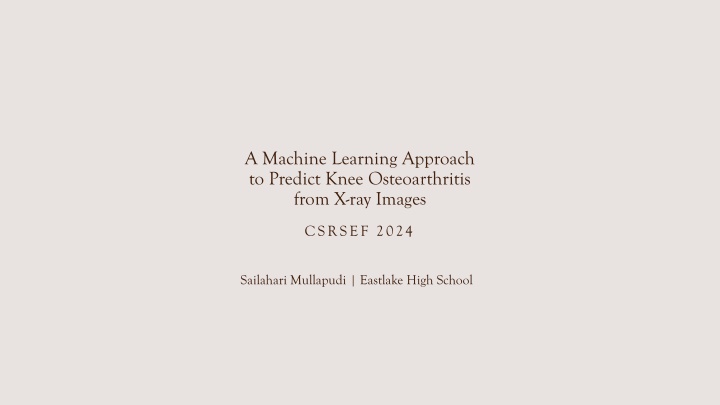
Predicting Knee Osteoarthritis Using Machine Learning from X-ray Images
"Explore a machine learning approach to predict knee osteoarthritis from X-ray images, addressing the limitations of traditional diagnostic methods. Leveraging logistic regression, support vector machine, and random forest models, this study aims to enhance accuracy and effectiveness in detecting knee osteoarthritis early on. Discover the Kellgren and Lawrence system for OA classification, dataset insights, model accuracies, and sensitivity-specificity analysis. Follow the advancements in computational diagnosis for knee health management."
Download Presentation

Please find below an Image/Link to download the presentation.
The content on the website is provided AS IS for your information and personal use only. It may not be sold, licensed, or shared on other websites without obtaining consent from the author. If you encounter any issues during the download, it is possible that the publisher has removed the file from their server.
You are allowed to download the files provided on this website for personal or commercial use, subject to the condition that they are used lawfully. All files are the property of their respective owners.
The content on the website is provided AS IS for your information and personal use only. It may not be sold, licensed, or shared on other websites without obtaining consent from the author.
E N D
Presentation Transcript
A Machine Learning Approach to Predict Knee Osteoarthritis from X-ray Images CSRSEF 2024 Sailahari Mullapudi | Eastlake High School
Healthy Knee Background: Knee Osteoarthritis (KOA) Knee osteoarthritis (KOA) is a degenerative disease that affects the knee joint Affects 1 out of 7 adults/over 520 million people worldwide Costs around 303 billion dollars annually No drugs to delay progression End stage disease: total knee replacement Severe KOA
Problem X-rays are the standard clinical procedure for radiographic knee osteoarthritis diagnosis not reliable, misdiagnosis rates high (day-to-day of 5%) Need for alternative methods Proposal: Using machine learning methods to predict which patient knees will develop knee osteoarthritis within a specific follow-up period Expected Outcome: Computational methods should be more effective and accurate compared to traditional radiographic diagnosis methods
Methods Logistic Regression (LR), Support Vector Machine (SVM), and Random Forest (RF) Public dataset - 10486 knee X-ray images (7 GB of image data) Data classified into 5 classes by the Kellgren and Lawrence (KL) system Data preprocessing Label Encoding GridSearchCV search for best hyperparameters Juypter Notebook (Python v. 3.9.12 and Scikit-learn python package v. 1.2.1) Pandas, Numpy, Seaborn, Matplotlib GitHub Repo: https://github.com/sailaharimullapudi/KOA- Models.git
Kellgren and Lawrence System of OA Classification grade 3 moderate grade 1 doubtful grade 0 healthy grade 2 minimal grade 4 severe
Accuracy Random Forest: 50.1% Support Vector Machine: 48.6% Logistic Regression: 46.3% Confusion Matrix the errors in classification are with the doubtful class being predicted as either healthy or minimal
Sensitivity & Specificity Inverse relationship between sensitivity and specificity Sensitivity values generally higher than specificity LR: balanced performance across all classes
ROC curves & AUC values The AUC values range from 0.55 to 0.95 Severe and Moderate classes have the highest (0.8 to 0.95) RF performed the best (0.71 0.94) Good overall model performance in distinguishing between positive and negative tests
Single Image Prediction Can be used on a single image Image fed through RF model and percentage probability for each class given as output Predicted label of X-ray: Doubtful True label of X-ray: Doubtful img=imread(img_path) plt.imshow(img) plt.show() l=[img.flatten()] Healthy = 3.0% Doubtful = 62.0% Minimal = 20.0% Moderate = 9.0% Severe = 6.0% probability=rf.predict_proba(l) for ind,val in enumerate(list_of_classes): print(f'{val} = {probability[0][ind]*100}%') The predicted knee OA grade is : Doubtful
Outcome & Future Works Outcome: Machine Learning approach is more efficient and enables faster clinical decisions for early diagnosis of KOA Future Steps: Running models on cloud service, and connect models to external data source to constantly train the models with new data Integrating multiple different medical imaging data and to include biochemical markers found in synovial fluids
Bibliography Brady, Adrian P. Error and discrepancy in radiology: inevitable or avoidable?. Insights into imaging vol. 8,1 (2017): 171-182. doi:10.1007/s13244-016-0534-1 Larsen, Jesper Bie et al. Five-year follow-up of patients with knee osteoarthritis not eligible for total knee replacement: results from a randomized trial. BMJ open vol. 12,11 e060169. 25 Nov. 2022, doi:10.1136/bmjopen-2021-060169 Gwynne-Jones, Julia H et al. The Outcomes of Nonoperative Management of Patients With Hip and Knee Osteoarthritis Triaged to a Physiotherapy-Led Clinic at Minimum 5-Year Follow-Up and Factors Associated With Progression to Surgery. The Journal of arthroplasty vol. 35,6 (2020): 1497-1503. doi:10.1016/j.arth.2020.01.086 Wang, Qiuke et al. The Added Value of Radiographs in Diagnosing Knee Osteoarthritis Is Similar for General Practitioners and Secondary Care Physicians; Data from the CHECK Early Osteoarthritis Cohort. Journal of clinical medicine vol. 9,10 3374. 21 Oct. 2020, doi:10.3390/jcm9103374 Xuan, Anran et al. The application of machine learning in early diagnosis of osteoarthritis: a narrative review. Therapeutic advances in musculoskeletal disease vol. 15 1759720X231158198. 14 Mar. 2023, doi:10.1177/1759720X231158198 Hirvasniemi, J et al. The Knee OsteoArthritis Prediction (KNOAP2020) challenge: An image analysis challenge to predict incident symptomatic radiographic knee osteoarthritis from MRI and X-ray images. Osteoarthritis and cartilage vol. 31,1 (2023): 115-125. doi:10.1016/j.joca.2022.10.001 Heidari, Behzad et al. Determinants of pain in patients with symptomatic knee osteoarthritis. Caspian journal of internal medicine vol. 7,3 (2016): 153-161. Kohn, Mark D et al. Classifications in Brief: Kellgren-Lawrence Classification of Osteoarthritis. Clinical orthopaedics and related research vol. 474,8 (2016): 1886-93. doi:10.1007/s11999-016-4732-4 Kokkotis, C et al. Machine learning in knee osteoarthritis: A review. Osteoarthritis and cartilage open vol. 2,3 100069. 4 May. 2020, doi:10.1016/j.ocarto.2020.100069 Chen, Pingjun (2018), Knee Osteoarthritis Severity Grading Dataset , Mendeley Data, V1, doi: 10.17632/56rmx5bjcr.1
